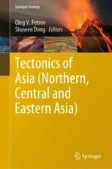Search
Search Results
-
Carboniferous back-arc extension in the southern Yili-Central Tianshan Block and its significance to the formation of the Kazakhstan Orocline: insights from the Wusun Mountain volcanic belt
In Central Asia, the Carboniferous is a crucial period in the formation of the Tianshan Belt and associated bending of the Kazakhstan tectonic...

-
Evolution and final closure of the Mongol-Okhotsk Ocean
Mongol-Okhotsk Orogenic Belt is the last main orogen that constructs modern tectonic framework of northeastern Asia. It has recorded the long-term...
-
Porphyry Deposits of Northern Eurasia: Practical Aspects of Tectonic Control, Structural Features and Estimates of Depth of Erosion from the Urals to the Pacific
AbstractHigher gold grades (0.1–1 g/t) in porphyry systems of northern Eurasia make them competitive with the Andean porphyries despite usually...

-
Extensional magmatism caused by strain partitioning: insights from the mafic dikes hosted in Biesituobie batholith in West Junggar, CAOB
The connection between magmatism and the tectonic environment is essential yet highly debatable. The West Junggar, CAOB, outcropped a swarm of...

-
Tectonic Domains of Northern Asia
The chapter gives a brief description of the geology and tectonic evolution of large geological structures in Northern Asia, such as orogenic systems...
-
Timing of the final closure of the Paleo-Asian Ocean: Evidence from sedimentary and volcanic rocks of the Linxi Formation in southeastern Inner Mongolia, China
The Paleo-Asian Ocean (PAO) had multiple collage systems and closed along multiple sutures. The final timing of the closure of the PAO was closely...

-
Accretionary processes and metallogenesis of the Central Asian Orogenic Belt: Advances and perspectives
As one of the largest Phanerozoic orogens in the world, the Central Asian Orogenic Belt (CAOB) is a natural laboratory for studies of continental...
-
Depositional Responses to the Mongol-Okhotsk Ocean Closure in the Central Area of the Great **ng’an Range: Insights into Thrust Faults and Foreland Basins
The Mongol-Okhotsk Ocean, which has been closing gradually from the west to the east beginning since the Late Paleozoic, was an important part of the...
-
Spatial and Temporal Distribution Patterns of Mafic Dyke Swarms in Central Asia: Results from Remote-Sensing Interpretation and Regional Geology
Mafic dykes in continents are a special type of intrusive rock formed by different tectonic events including earlier fracturing deformation in host...
-
The Tectonic Evolution of Asian Continental Lithosphere
The Asian continental lithosphere underwent very complex formation processes. During its long-term tectonic evolution, multi-directional collisions...
-
Tectonic Domains and Tectonic Units in Asian Continent
The Siberian tectonic domain (Fig. 2.1) is located in the northern part of Asian continent. The center is Siberian plate [1], around which there are...
-
From Kenorland to Modern Continents: Tectonics and Metallogeny
AbstractThere are three stages in tectonic evolution of the Earth: (1) nucleation, from the origin of protocratons to their assembly into the...

-
Three Dimensional Crustal Density Structure of Central Asia and its Geological Implications
This paper introduces the scale-depth law of multi-scale wavelet analysis for regional gravity data processing, and presents the results of its...
-
Paleomagnetic evidence for local oroclinal bending in the eastern Korean Peninsula
A paleomagnetic investigation has been carried out for the Lower Triassic Donggo Formation exposed in the Danyang area on the Yeongnam Massif to...
-
Paleomagnetism of Permian rocks of the Subpolar Urals, Kozhim River: To the history of evolution of the thrust structures in the Subpolar Urals
The collections of Permian rocks from sections of the Kozhim River (Asselian, Kungurian, and Ufimian stages) and the Kama River (Ufimian and Kazanian...
-
Toward a unified model of Altaids geodynamics: Insight from the Palaeozoic polycyclic evolution of West Junggar (NW China)
The Altaid tectonic collage extends over Central Asia, exposing numerous accretionary orogens that can account for the Palaeozoic continental crust...
-
A Review of Recent Developments in the Study of Regional Lithospheric Electrical Structure of the Asian Continent
The Asian continent was formed through the amalgamation of several major continental blocks that were formerly separated by the Paleo-Asian and...

-
Lateral variation in seismic velocities and rheology beneath the Qinling-Dabie orogen
The Qinling-Dabie orogen is an important tectonic belt that trends east-west and divides continental China into northern and southern parts. Due to...
-
A new look at the Precambrian and Cambrian event chronostratigraphic correlation of Mongolia
The Mongolian Precambrian and Cambrian event chronostratigraphic classification of sedimentary, sedimentary—volcanogenic, volcanogenic, and...
-
Corresponding Main Metallogenic Epochs to Key Geological Events in the North China Craton: An Example for Secular Changes in the Evolving Earth
Precambrian period is an oldest and longest eon from 545 Ma to about 4500 Ma, taking over ~90 % of the Earth’s history. The 80–90 % continental crust...
